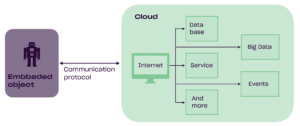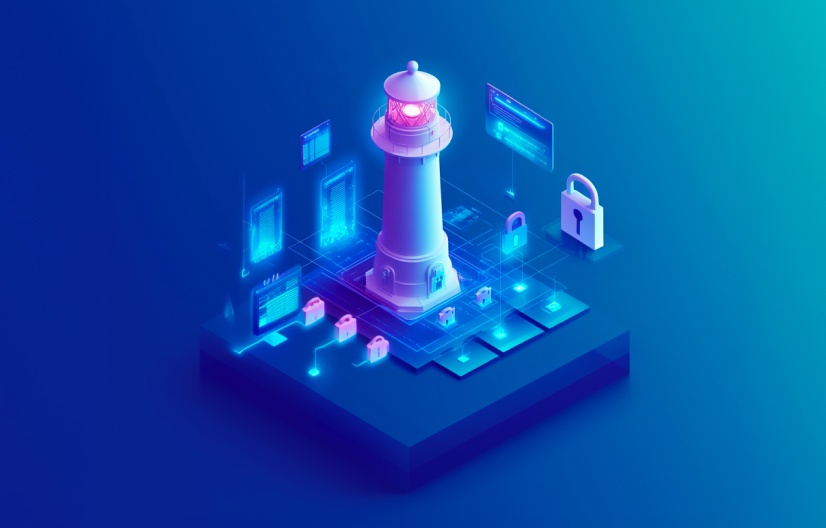
The Internet of things and Microsoft Azure : a practical example
Is your appliance is on the fritz and acting up again? If it’s connected to the Internet, instructions will appear on your cellular phone. If you follow these instructions to the letter, you will be able to resolve the issue without having to call a technician. Efficient and inexpensive: That’s the Internet of Things (IoT) in a nutshell.

As you can see in the illustration above, the statistics that demonstrate the growth of this industry are far from surprising. In fact, the number of embedded objects has been growing at a rate of 31% per year since 2015 and will surpass the 30 billion mark in 2020. representing a market of $1,700 billion that year.
The Internet of Things (IoT) combines the physical world – industrial equipment, everyday appliances, cars – with computer systems. Devices such as sensors and microchips, in the objects themselves, collect information and exchange data. The objects are connected through a network infrastructure where they can be recognized and controlled remotely.
A revolution for businesses
The advent of electronic devices into people’s daily lives not only reduces the need for human intervention, but also represents substantial savings. However, the situation is different for companies since this evolution – or should we say revolution! – does affect the normal course of their business in terms of processes, production and strategy.
Several companies have undertaken the huge shift in digital transformation, while others are seriously thinking about it. However, before they invest in this new way of doing things, business owners and leaders need to understand the ins and outs of this transformation and then define strategies that will address future issues and challenges.
Questions to ask:
- How can we configure embedded objects and properly send them commands?
- How can we ensure their security so they are not vulnerable to hackers?
- How do we guarantee a continuous service?
- How can we take advantage of the cloud model and all its benefits?
Even though there seems to be a never-ending list of questions, the benefits and potential uses of object connectivity are becoming increasingly apparent. That is to say connected systems are designed for automation, security, energy efficiency, quality of life, increased productivity and error reduction.
Eventually, your business will begin its digital transformation. When that day comes, be informed so you can enjoy all the benefits of IoT.
A picture is worth a thousand words
The image below illustrates a basic IoT system: The embedded object on the left communicates with the Internet on the right. The object can use all the services offered by the platform, including, but not limited to: a database to store the information of the objects in the field or on site; Big Data to analyse this information; alerts and notifications in the case of critical situations; data transmission from one object to another; instant messages sent in real-time in the case of malfunctions; real-time display of the data captured, real time display of the object’s location; batches of commands that can be sent simultaneously to all embedded objects, etc.

Microsoft Azure IoT
The illustration above represents the Azure platform: Microsoft’s cloud-based solution. Microsoft’s renowned expertise and Azure’s many benefits, including size, value for money and power, make it Logient’s number one choice when it comes to realizing projects for its clients.
Azure offers four IoT solution architectures or configurations that can be used independently or concurrently.

All Microsoft solutions provide security and scalability. Technically speaking, Microsoft supports the AMQP, MQTT and HTTPS protocols to communicate with devices. As for the costs related to the Azure IoT, know that this Microsoft platform is the least expensive on the market and that billing is based on usage. In addition, rest assured that Logient will be there to help you establish your budget.
Integration into a connected device or embedded electronic system
Objects that need to be connected must all be linked to a connected device called an embedded electronic system. This system includes dedicated electronic hardware and embedded software to which you’ll need to add the Microsoft Azure SDK (Software Development Kit). This SDK is available in several programming languages, including C and Python. It is also already supported on multiple hardware platforms and multiple operating systems.
Moreover, if your company manufactures embedded products such as electronic controllers, calculators, electronic thermostats, alarm systems, PLCs etc., you will need to make hardware and software changes to your product so they can support the selected architecture. For example, you might need to add a Bluetooth BLE 5 communication module for communications with an IoT Edge system, or change some software features in order to render possible the exchange of information between the device and the cloud.
As for the libraries, many hardware manufacturers (ST, ARM, ESP, etc.) already offer libraries to integrate with your systems.
Research study
Context
A company uses an environmental data control, measurement and storage system with an electronic device. This data is analyzed and used to control mechanical and electrical devices, such as industrial furnaces, temperature chambers and incubators.
The monitoring system is comprised of different embedded elements and uses the cloud for certain functionalities. Inasmuch:
- The electronic device has a USB port that enables the connection of a tablet, which is used to manage the device, configure it, update it or extract data from it.
- The electronic device has a retractable, flash memory card that contains data related to the system’s operation.
- A local internet connection allows users to visualize the data in a Web browser.
- A home network can be used to store certain data.
Business requirements
The company wants to improve the performance of its system and electronic device in addition to increasing object connectivity.
Solution
The integration of the Azure IoT Hub can optimize both the monitoring system and its electronic device. In fact:
- The monitoring, reading of the system parameters and updates to the embedded software can take place directly from the Azure console, thus removing the need for the USB port.
- The development of an Azure Web application eliminates the need to rely on a tablet.
- The addition of a database to store the information in a log file provides a way to access this information remotely and eliminates the need to use a flash card to retrieve data.
- Using the Azure solution also eliminates the need to rely on an expensive and often vulnerable home network.
Benefits
The Azure cloud solution provides the following benefits:
- Reduces the manufacturing costs of the device.
- Reduces the costs associated to home networks.
- Increases the security of connected and cloud computing systems.
- Reduces the maintenance efforts related to the embedded systems, since the application has been simplified and now depends on fewer components.
- Reduces the number of on-site interventions, since the Azure console allows remote logging to all the systems deployed for every client.
- Increases the potential services offered by the company, including the creation of dashboards and reports on the delivered systems’ usage.
How Logient can help you
In addition to helping you establish your budget, Logient can assist you during your digital transformation. We are experts when it comes to Microsoft Azure and are able to offer the entire range of services required to take advantage of the Internet of Things:
- The development of embedded software;
- Connecting devices to the cloud;
- Cloud connectivity strategy;
- The development of reports and automated dashboards as well as the extraction of KPIs;
- Integration of libraries with your systems;
- Consulting services.
Logient offers a wide range of services applicable at every stage of the development process. Whether you want us to take care of an entire project from beginning to end or simply require assistance during a particular phase, Logient has the required expertise and resources to meet your requirements – whatever they are.
Need more information? Contact us!
[1] https://en.wikipedia.org/wiki/Internet_of_things (consulté le 2018-12-03) / [2] https://www.directioninformatique.com/internet-des-objets-un-marche-de-1700-g-dici-2020-au-quebec/52283 / [3] http://www.w11stop.com/blogs/iot-in-2020/



















